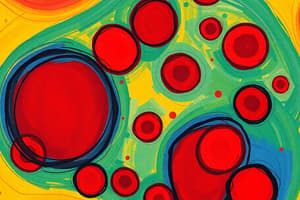Podcast
Questions and Answers
Which of the following is NOT a characteristic of cytoplasmic inclusions?
Which of the following is NOT a characteristic of cytoplasmic inclusions?
- They are non-living structures.
- They may not be present in all cells.
- They have little or no metabolic activity.
- They are essential for cell vitality. (correct)
What is the primary site for glycogen storage in the body?
What is the primary site for glycogen storage in the body?
- Liver and muscle cells (correct)
- Skin and nerve cells
- Kidney and spleen cells
- Muscle and fat cells
Which stain would you use to identify glycogen in liver cells?
Which stain would you use to identify glycogen in liver cells?
- Best's carmine (correct)
- Periodic Acid Schiff (PAS) (correct)
- Sudan III
- Osmic acid
Which of the following is an example of an endogenous pigment?
Which of the following is an example of an endogenous pigment?
Which pigment is known for its ability to protect skin cells from ultraviolet radiation?
Which pigment is known for its ability to protect skin cells from ultraviolet radiation?
What is the function of the smooth endoplasmic reticulum (SER) in muscle cells?
What is the function of the smooth endoplasmic reticulum (SER) in muscle cells?
Which organelle contains enzymes for the citric acid cycle?
Which organelle contains enzymes for the citric acid cycle?
Which statement correctly describes the inner mitochondrial membrane?
Which statement correctly describes the inner mitochondrial membrane?
Which process is defined as the discharge of materials from a cell involving vesicles?
Which process is defined as the discharge of materials from a cell involving vesicles?
Which of the following features best describes cytoplasmic organelles?
Which of the following features best describes cytoplasmic organelles?
Flashcards
Cell Inclusions
Cell Inclusions
Non-living structures formed from metabolic products of cells. They lack membranes, have little metabolic activity, and aren't crucial for cell survival.
Glycogen Storage
Glycogen Storage
Carbohydrate stored in liver and muscle cells; appears vacuolated with H&E stain and stained magenta-red with PAS.
Fat Storage in Cells
Fat Storage in Cells
Lipids stored as lipid droplets mainly in fat cells. Appears vacuolated with H&E, stained with Sudan III (orange), Sudan Black (black), or Osmic Acid (black).
Endogenous Pigments
Endogenous Pigments
Signup and view all the flashcards
Exogenous Pigments
Exogenous Pigments
Signup and view all the flashcards
Prokaryotic Cell DNA Structure
Prokaryotic Cell DNA Structure
Signup and view all the flashcards
Eosin Stain Affinity
Eosin Stain Affinity
Signup and view all the flashcards
Cytoplasmic Organelle Function
Cytoplasmic Organelle Function
Signup and view all the flashcards
Exocytosis Definition
Exocytosis Definition
Signup and view all the flashcards
Mitochondria Division
Mitochondria Division
Signup and view all the flashcards
Study Notes
Cell Inclusions
- Cell inclusions are structures formed from metabolic products of cells.
- They are non-living structures, having little to no metabolic activity.
- They are transitory and not essential for cell vitality.
- Most inclusions are not enclosed by a membrane, except melanin.
- Inclusions aren't present in all cells.
Types of Inclusions
- Inclusions can be categorized into stored foods and pigments.
- Stored foods include glycogen and fat.
- Pigments are naturally colored materials, and categorized as endogenous or exogenous.
- Endogenous pigments are generated within the body, examples include hemoglobin and hemosiderin.
- Hemoglobin is a red pigment in red blood cells (RBCs) and is an iron-containing pigment. It results from phagocytosis of RBCs. Prominent in liver and spleen macrophages.
- Hemosiderin is a dark brown, iron-containing pigment in the liver and spleen macrophages. It's also created when RBCs are phagocytosed.
- Melanin is another endogenous pigment; dark brown granules from melanocytes in the skin. Melanin also protects skin from UV radiation.
- Lipofuscin is a golden brown pigment found in cardiac muscle and nerve cells from the accumulation of lysosomal waste products.
- Exogenous pigments are introduced into the body from outside, such as Carotene (yellow pigment in carrots) and carbon or dust particles in dust cells (macrophages) in the respiratory system. Tattoo marks are also exogenous pigments.
Stored Food (Glycogen):
- Glycogen is primarily stored in liver and muscle cells.
- Light microscopy (LM) observations of glycogen often show a vacuolated appearance due to dissolution during sample preparation.
- Special stains like Best's carmine and Periodic Acid Schiff (PAS) stain glycogen magenta red.
- Electron microscopy (EM) shows glycogen as electron-dense granules.
Stored Food (Fat):
- Fat is primarily stored in fat cells as lipid droplets.
- LM observation of fat often shows a vacuolated appearance due to sample preparation.
- Special stains like Sudan III stain fat orange, Sudan Black stains fat black, and Osmic acid stains fat black
Other Key Concepts
- Prokaryotic cells: Their DNA is circular and is not complexed with histones.
- Eosin stain: Stains basic structures in a cell.
- Cytoplasmic organelles: Essential for cell life.
- Exocytosis: The discharge of materials in cytoplasmic vesicles from a cell following fusion with the cell membrane.
- Organelles that can divide: Mitochondria.
- Organelle for intracellular calcium regulation in muscle contraction: Smooth Endoplasmic Reticulum (SER).
- Location of citric acid cycle enzymes: Mitochondrial matrix.
- Organelle increasing surface area for ATP production: Inner mitochondrial membrane.
- Synthesis of cell membrane proteins: Rough Endoplasmic Reticulum (RER).
Studying That Suits You
Use AI to generate personalized quizzes and flashcards to suit your learning preferences.




